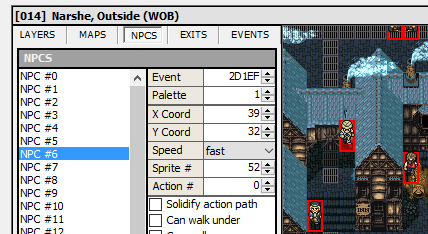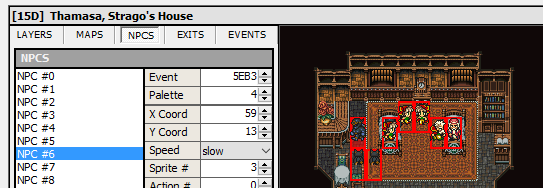This is an old revision of the document!
Action Queues
One question that you may have been asking yourself is “How do I make the characters move”? Action queues contain a set of actions that you want a character to perform. For example, you could queue up the actions “walk one step up”, “turn left”, and “nod head left”. If you set the action queues up correctly, you can have multiple characters executing a complex series of actions at the same time. If you've been following the tutorial so far, action queues will be fairly straightforward to learn.
Starting an Action Queue
Starting an action queue works just like executing any other event command, although the number of parameters can vary depending on how many actions you want the character to take. Any command between $00 and $34 will start an action queue for one character. The Event Command Document has some information on which character will take action. This character will fall into one of the following categories:
- $00 - $0F: Player characters. For example, $00 begins an action queue for Terra, and $01 begins one for Locke. $0E and $0F are special in that they begin action queues for temporary characters like Banon and Leo. Be careful, as the game often uses NPC lookalikes that resemble the player characters; those fall into the next category.
- $10 - $2F: Non-player characters. Different NPCs will take action depending on what map is loaded. You can cross-reference the Event Commands Document and FF6LE to figure out which command corresponds to the NPC that you want to move. According to the Event Commands Document, the $16 command will begin an action queue for NPC 6 in FF6LE. If you open the LE and select “[014] Narshe, Outside (WOB)”, you can see that NPC 6 is a guard on this map. If you select “[15D] Thamasa, Strago's House”, you can see that NPC 6 is a lookalike of Shadow on this map.
- $30: The camera. You can make the camera “walk” around the map, just like any other character. If you tell the camera to move upwards eight steps, the player's view will shift eight tiles upwards.
- $31 - $34: The characters in the party. Often, the player has the opportunity to pick a party of their choosing, so you won't know what characters are in the party during your event. By using the $31 command, you can move whomever happens to be leading the party. Figuring out which character is in the lead (and then moving them manually) would be a lot more difficult.
The Second Byte
The main purpose of the second byte is to tell the game how long the action queue will be. Most of the time, you should decide what actions you want to put in the queue before filling in this byte. You can have up to $7F (127 in decimal) actions in a queue, but it's unlikely that you will need anywhere near that many.
This byte also allows you to tell the game whether you want to finish the character's actions before moving on with the event. If you add $80 to this byte (after figuring out how long you want the queue to be), the game will wait for a character's actions to finish before moving on. Otherwise, the game will not wait. The latter is useful if you want to make multiple characters move at the same time, among other things.
The Actions
This is the main meat of the action queue, containing the actions that you want the character to perform. There is a list of actions here. The vast majority of these are self-explanatory. Many just tell the character to strike a pose or walk somewhere. The commands from $C0-$C4 allow you to change how fast the character walks when they move. Ignore the commands related to branching or setting event bits for now; these will be covered in later sections of the tutorial.
By default, a character will actually take footsteps when they are told to move somewhere. If you execute the $80 command (Move character up 1 tile), then the $82 command (Move character down 1 tile), the character will take one step upwards and one step downwards. If your intention was to make a character float up and down while facing forwards, these footsteps would need to be disabled by placing a $C7 command in the character's action queue. In other words, the middle of your action queue might contain the following commands: CE C7 80 82.
You should also take note of the E0 command. Delays tend to be very important in action queues because it takes a very short amount of time for characters to strike poses. Let's say that you want a character to shake their head back and forth. You may be tempted to alternate between $23 and $63. Unfortunately, the game will switch between $23 and $63 so quickly that the player won't be able to see it! Inserting a short delay between these poses will fix the issue. Instead of using 23 63 23 63, you might want to use 23 E0 01 63 E0 01 23 E0 01 63. Unfortunately, even the shortest delay ($01) is too long for some purposes. To create a very tiny delay, we can create four tiny action queues in a row, instead of creating one action queue with all four head-shaking poses in it. No $E0 delays are necessary; since it takes a moment for the game to end an action queue and start the next one, the player will be able to see the pose for a brief instant. This is a trick that the vanilla designers used fairly often.
All action queues need to be ended with the $FF command. Once you have finished the body of your queue, don't forget to count how long it is and fill in the second byte. The $FF command at the end should also be included in this count.
Our First Action Queue
It's finally time to fix our problem from earlier. In order to prevent the event from repeating, we want the party to step off the event tile before the event ends. We could use $00 to begin an action queue for Terra, but we don't know who will be leading the party when the player steps on the event tile. If the player were to switch Biggs to the front of the party, our event would fall apart. Therefore, we should begin the queue with the $31 command.
We'll come back to the second byte later.
The body of this queue is very straightforward. We just want Terra to take a single step upwards. Looking at the Movement Action Commands, we can see that the $80 command will accomplish this. Finally, we need to complete the queue with $FF.
Now we need to fill in the second byte. Our action queue only contains two bytes: $80 and $FF, so we'll start with the value $02. We also want to wait for the party's movement to end before continuing the event, so we need to add $80, giving us a total of $82.
And that's it! The resulting action queue is 31 82 80 FF. As of now, this is the whole event:


